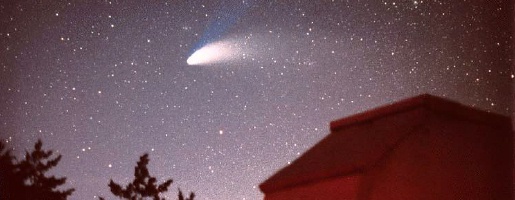 |
|||||
|
Hale-Bopp's size and brightness dominated the sky in
1997.
|
|||||
| COMET HALE-BOPP | |||||
| Hale Bopp was one of the brightest comets of the 20th Century. It was found by two amateur astronomers, Alan Hale and Thomas Bopp, independently of one another, both observing in the American southwest on 23rd July, 1995. Later in 1995 it was visible through small telescopes, but invisible in the Sun's glare during December 1995 and January 1996. When it came back into view it had increased in visibility and in May 1996, the first naked-eye observation was reported. | |||||
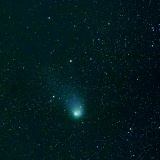 Hale-Bopp first became visible through small telescopes in 1995. |
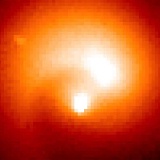 At such a great distance, Hale-Bopp structure was best seen with the Hubble Space Telescope. |
||||
| Hale-Bopp's brilliance enabled its discovery beyond the orbit of Jupiter at a distance of more than a thousand million kilometres. Hale-Bopp is unusual in being so bright at so great a distance from the Sun. Normally a comet is much closer to the Sun before gases are heated and sublimated (turning from a solid directly to a gas), and particles bound in with the ices are released from the comet forming their bright tail. When 180 million kilometres from the Sun, Hale-Bopp was streaming 200 times more dust than Halley and about 100 times more than Hyakutake for the equivalent surface area. | |||||
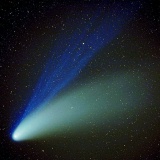 Hale-Bopp quickly developed an impressive double tail. |
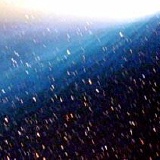 The blue tail is the ionised gas tail, the brighter tail is composed of dust. |
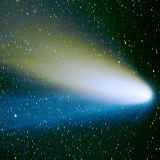 Close-up view of Hale-Bopp's ion tail, caught and extended by the solar wind. |
|||
| Hale-Bopp is quite a big comet, one of the largest comets to have visited the inner Solar System. Hubble Space Telescope images indicated that the solid part of the comet, called the nucleus, was about 40 kilometres across. Most comets are much smaller, less than 5 kilometres in diameter. | |||||
| Though Hale-Bopp was big and bright, it didn't come very close to the Earth. On March 22nd it made its closest approach. At this point it was 197 million kilometres away - further than the distance from the Sun to the Earth. If it had come as close as Hyakutake (15 million kilometres) it would have appeared six times as bright as Venus. | |||||
| Through a large telescope, detail in the structure of Hale-Bopp's dust emissions could be seen. Concentric shells of bright material were also perceived, the innermost of which appeared connected to the body of the comet by a dusty bar | |||||
|
|
|||||
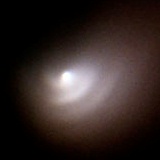 Hale-Bopp exhibited concentric shells around its nucleus. |
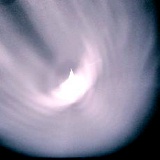 Hale-Bopp's spin generated a shell structure around its coma. |
||||
| Hale-Bopp was given much attention by the world's media. And though it was not the brightest comet of the 20th century, it was probably the most widely viewed. Its longevity in the night sky enabled many people to witness their first bright comet. The last comet to have been visible for anything like as long as Hale-Bopp, 17 months in all, was the Great Comet of 1811 which was visible for 10 months. | |||||
|
|
|||||